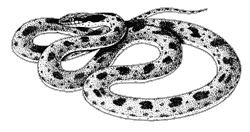Desert Nightsnake
(Hypsiglena chlorophaea)
Order: Squamata
Family: Colubridae (colubrid snakes)
Spanish names: culebra
Distinguishing Features
This small 12 to 26 inch (30 to 66 cm) snake has a triangular-shaped head, a dark eyestripe, and elliptical pupils; it is often mistaken for a young rattlesnake. The night snake is easily distinguished from the latter by a tail that tapers to a point and the absence of a rattle. The night snake has a pair of large, dark brown or black blotches on the neck immediately behind the head. It is pale gray, light brown, or beige with dark gray, brown, or black blotches on the back and sides; the underside is white.

Range
The range of this snake extends from British Columbia through the western United States and south to Guerrero, Mexico.
Habitat
A habitat generalist, the night snake is found in rocky areas of grassland, chaparral, desertscrub, woodland, moist mountain meadows, and thornscrub from sea level to 8700 feet (2650 m).
Life History
Seldom encountered during the day, this nocturnal snake is often seen crossing roads at night. The night snake preys upon lizards, small snakes, frogs, salamanders, and small mice, which it subdues with its mild venom; this venom poses no threat to humans. Young night snakes feed upon insects. If disturbed, the night snake raises its head and weaves, hisses, and flattens its neck in threat. Two to 9 eggs are laid spring through summer.










